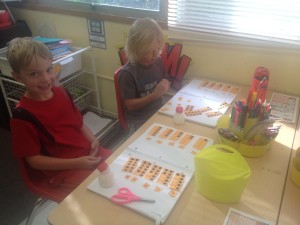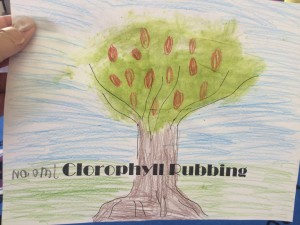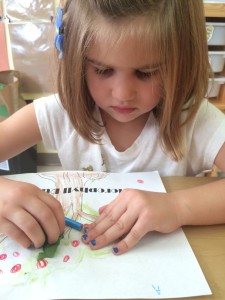Language Arts & Math
One of the stories we read this week was Annbelle Swift, Párvula. When Annabelleʼs older sister, Lucy, tries to prepare her for her new school experience, not all of Lucyʼs advice is helpful. In the end, however, Lucyʼs tutoring finally pays off. Your children love to share about themselves so we heard many stories relating to their own experiences. We worked on the reading comprehension strategies of Asking Questions and Predicting. Right now I am modeling this for the students so they will begin to actively do this on their own. These are definitely things you can do when you are reading at home: “Why do you think he did that?” or “What do you think will happen next? Why?”
Students welcomed fall with a journal writing, detailing their favorite things about fall. For this writing we brainstormed possible answers, created a word bank, and worked on leaving spaces between our words, using a capital for the first word in our sentence, and the correct punctuation at the end. The students used the classroom writing rubric to self-monitor.
We continued our daily letter practice. Handwriting is important and we will do more and more writing as the year goes on. Letter recognition (Spanish) is also coming along very nicely.
In math this week we introduced Math Interactive Journals. These will stay at school but are a great way for students to practice: fine motor skills, manipulating objects, checking their math knowledge, reinforcing classroom lessons. This week the students added a frog pocket and read: Hay 3 (1,2,4, 5) ranas. (There are 3 (or 1,2,4,5) frogs.) They also added tens frames and placed the correct numeral next to the correct frame.
for students to practice: fine motor skills, manipulating objects, checking their math knowledge, reinforcing classroom lessons. This week the students added a frog pocket and read: Hay 3 (1,2,4, 5) ranas. (There are 3 (or 1,2,4,5) frogs.) They also added tens frames and placed the correct numeral next to the correct frame.
Letters studied this week: Ss, Bb, Nn, Pp
Sight Words introduced this week: El (the), La (the), Las (the), Los (the)
How do we know when to use which the? Practice, listening, exposure, reading. The students will automatically hear the difference, from repeated exposure, and understand singular/plural and then eventually masculine/feminine. For now, it’s just exposure and knowing it’s either one or more than one.
Social Studies & Science

 This week we compared deciduous to evergreen trees and learned that deciduous trees lose their leaves in the fall and evergreens stay green and keep their leaves year round. We went on a nature walk and identified both of these. We collected leaves of both and sorted them according to whether they were deciduous or evergreen. We learned about clorophyll being the chemical in a plant that makes it the color green. The students had fun coloring a tree with clorophyll (we used spinach to color the leaves on a tree green).
This week we compared deciduous to evergreen trees and learned that deciduous trees lose their leaves in the fall and evergreens stay green and keep their leaves year round. We went on a nature walk and identified both of these. We collected leaves of both and sorted them according to whether they were deciduous or evergreen. We learned about clorophyll being the chemical in a plant that makes it the color green. The students had fun coloring a tree with clorophyll (we used spinach to color the leaves on a tree green).Music
This class met Sr. Kit’s harp for the first time, and discovered that several of the songs they have learned can be accompanied by harp as well as guitar. The class also closed their eyes to see what images appear on the backs of their eyelids. In addition to rainbows, mermaids, unicorns and dolphins, one student saw soldiers – rather fascinating, as the composer of that particular piece was a regimental harper during Paraguay’s Chaco War.
Art
This week in Kindergarten Art class, the students learned about landscape painting. We looked at Gauguin’s “Tropical Landscape”, and the students learned how to use a variety of lines to draw a sky, mountains, and fields. Then they used tempera paint to add color to their picture. The students did a wonderful job! Their landscape paintings will serve as the background for a scarecrow collage which they will make next week. A SPECIAL THANKS to Alora’s mom, Tracy, who is helping out during the kindergarten art class! Also, a SPECIAL THANKS to Andres’s dad, Mr. Martinez, for sanding all the fence pieces which each grade level will be using.
